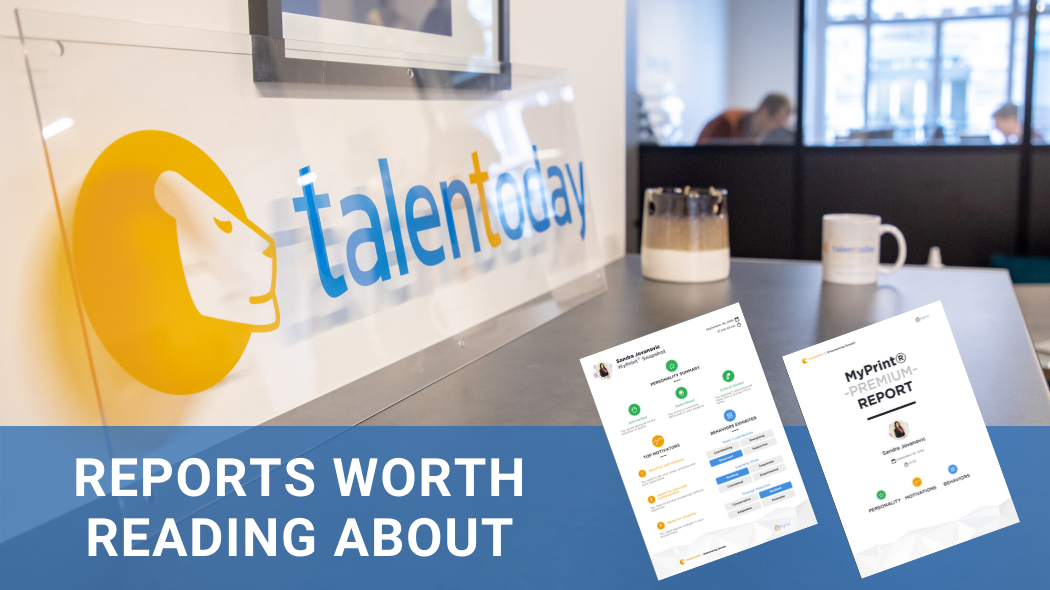Unique Results You Can Actually Use
It is human nature to be curious. That is why we hear children ask “why?” over and over again or take the online social media quizzes knowing that there is no validity in their results, but we are simply curious as to what TV character they might say we are or what movie our personality is most like.
When it comes to our personalities and soft skills, the right tools will allow you to leverage technology in order to capture, represent and report our human elements that make us unique in a simple way. That is exactly what Talentoday’s One Page and Premium Reports do!
Whether you are interested in learning more about yourself or thinking about using these reports to manage your team, let’s spend a couple minutes together learning about these two reports.
A Quick Review
After completing the MyPrintⓇ questionnaire, your results will be visualized into reports as a one-page or premium report. There are a total of 26 possible personality traits, 22 motivations and 44 possible behavioral types that will make up your unique results. Just think about the possibilities!
Three high-level definitions to keep in mind before we dive into the reports:
- Personality traits are used to describe the attitude and emotional characteristics of an individual
- Motivators are the reasons an individual acts or behaves in a particular way
- Behaviors help us understand how an individual acts or conducts themselves towards others
One Page Report
If your time is valuable and you want to understand the most pertinent information in a summarized format, then the one page report will be your best friend. This report is separated into three segments, including a personality summary, top motivators and behaviors exhibited. Essentially, it highlights the need-to-know information about your soft skills in each of the three areas and identifies the traits that make you, you!
The personality summary section displays the top three most distinct personality traits an individual possesses based on what Talentoday measures in our questionnaire. The top motivators section displays the top three most distinct motivators for an individual. Lastly, the behaviors exhibited section displays the three predominant behavioral styles of an individual.
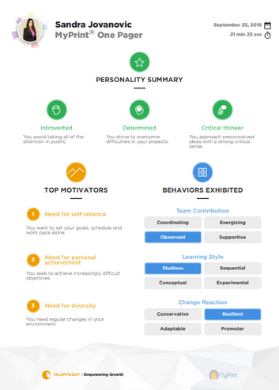
Premium Report
Now don’t worry, because we know comprehensive detail can’t be summarized in one page. So for all you that love to dig into the details, our premium report is perfect for you. This report contains over 30 pages of detailed information about every single personality and motivation trait, as well as your behavioral styles. In addition to the granular details, we see well summarized personality and motivation trait visuals with our easy-to-read personality radar and motivations scale.
The premium report not only provides you with the results and descriptions of your results, but also gives you recommendations on how to use those results. As we dig in to each personality trait, you will find additional tips to review. For motivators, we will not only understand what motivates the individual, but also what can discourage that person. In each behavioral style, we can understand the description of the style, assets, and questions to ask ourselves or the individual whose report we may be reviewing to dig into the behavior further.
Interested in what your personality, motivations and behaviors are but haven’t had a chance to experience MyPrintⓇ Of course, we would be too! Contact one of our Talentoday experts at contact@talentoday.com to experience the questionnaire and view your one page report as soon as you answer the last question. We can’t wait to hear what you think.
Stay tuned for more exciting product news! We know that 2020 is going to be ROARing!
If you’re interested in learning more information about Talentoday, please visit www.talentoday.com or contact our experts at contact@talentoday.com.
Employee Recognition to Turn the Holidays into the Season of Company Culture and Commitment

The holiday season can stir up a whirlwind of emotions inside and outside of work — from happy to excited, and for some, stressful. During the holidays, companies and teams may celebrate with special parties and events, but offices can also become ghost towns, with many employees taking additional time off. Adversely for some industries, the holiday season may be their busiest time of year.
Through the high points and low points of the holiday season, what can managers do to keep their employees motivated, while enhancing their commitment to the organization in the new year?
Make it Personal
Some organizations may have the luxury of being able to provide company-wide holiday presents and/or year-end bonuses, which can help with the overall sense fulfillment for employees. However, many companies do not have this option, or they feel like company-wide gifts may seem impersonal.
According to Great Place to Work, “It is key that employers focus on how they can make authentic and meaningful recognition part of their management philosophy in order to retain top talent and encourage high performance.” For managers, knowing that a need for unique recognition is important, the holiday season creates an opportunity to motivate employees on an individual basis to end the year strong!
Recognition Without Breaking the Bank
As can be seen by Talentoday’s assessment, individuals’ motivations are unique. While some people are heavily motivated by money, others may be more motivated by external recognition, or the ability to socialize.
To recognize individuals on your team, it could be as simple as writing an email or handwritten note, highlighting accomplishments throughout the year. Additionally, during the holiday season, employees may have the burden of hectic travel or spending their holidays away from their loved ones. For those teammates, consider giving them snacks for the road, a good book, or recommending a podcast to pass the time. For employees that will be spending time away from family and friends and missing their hometown, consider specific items that would remind them of home, such as candies, drinks, sports memorabilia or photos. Lastly, for employees who spend much of their year traveling for work, this is a great opportunity to provide a gift than can be shared with their family, such as a gift basket or a gift card for a meal together.
Establish Employee Commitment
Unfortunately for some organizations, the phrase, “new year, new me,” can often signal individuals looking to start a new job in the new year. Similarly, the start of the new year often means that new company budgets are established or replenished, allowing organizations to actively recruit.
Knowing this, the holiday season is a great time to ensure and re-establish commitment to the organization. Outside of recognizing individual achievements and rewarding employees on a more personal level, organizations can use this time to come together and reflect on the past year and provide transparency on goals for the upcoming year. Furthermore, outside of company-wide meetings, managers should be frequently engage employees by, “creating a respectful and trusting relationship with their direct reports, communicating company values and setting expectations for the day-to-day business of the organization,” as they play a key role in overall employee engagement.
As organizations are wrapping up their year-end initiatives and gearing up for 2020, it’s never too late to think of unique ways to serve and recognize the people giving back to the company on a daily basis. Whether a company is small or large, personalized actions or recognition can go a long way and can be done with little to no budget, allowing all employers a fair chance to motivate their teams this holiday season!
Knowledge Transmission and Engaging Expert Collaborators

In a global economy facing constant competition and ever-increasing challenges, companies must ensure the transmission of knowledge and know-how internally in order to move forward and progress. Knowledge management and internal knowledge sharing are crucial for companies to maintain critical skills.
Obstacles linked to human collaboration
Nowadays, the difficulty lies in the ability of organizations to stimulate a dynamic exchange of knowledge, while leveraging employee engagement. Due to a lack of self-confidence, demotivation or simply a lack of recognition from existing employee skills, employees are not always willing to cooperate and share their expertise. Management and managers will need to put in place incentives and develop a culture of recognition to improve knowledge transfer. It is necessary to set up a management system based on trust, a strategic lever in service of performance, for which the organizations HR or L&D leaders would be accountable for managing (1).
Multiple benefits for your company and your employees
The benefits for companies are plural. Knowledge management and transmission have a direct impact on financial gains and cost reduction through: expertise control, speed of task execution, productivity increase, error alleviation, risk management control, and time management for innovation. In fact, employees have increased motivation when they feel that they are acquiring skills quickly and can improve their work. Making them more inclined to change and ready to take up many challenges. In a world seen through the prism of the VUCA model, an acronym for “Volatility, Uncertainty, Complexity, Ambiguity”, organizations need a rapid transfer of knowledge in order to evolve and reinvent themselves, which requires a lot of agility and efficiency.
A new organizational model
New business models must be found while building on the knowledge and know-how, of the company’s core business. A new organizational model has emerged: the learning enterprise (2). In his research Jean-Louis Boutte explains and I quote: “ The company is now considered a living organism, beyond the biological and cybernetic brain, susceptible to organizational learning (Argyris and Schön, 1996). In this model, knowledge is considered as the first wealth and sources of added value. Cross-functionality, systematic networking and a permanent circulation of knowledge foster the emergence of new knowledge and collective intelligence.”
In the digital age, everyone becomes a contributor, designer, producer of ideas, content and opinions. This naturally leads to more collective and cooperative modes of organization that gradually replace pyramidal, hierarchical organizations. Ensuring the management of employees’ knowledge and skills assets becomes a source of sustainable corporate performance and employee employability, loyalty and engagement.
Sources:
- Management par la confiance et performances: Contributions actuelles et perspectives pour la fonction RH, Anne-Sophie Attia, Carole Legros Bradol, Flore de Soultrait et Marco dalla Palma ,Jean-Nicolas Moreau, Université Paris-Dauphine., 2017
- Transmission de savoir-faire, Réciprocité de la relation éducative Expert-Novice, Jean-Louis Boutte, Université de Provence, 2007.
Leveraging Motivation and Engagement and Navigate Change

In response to an ever-evolving economic environment, companies undergoing institutional change look to leverage the power of employee engagement. However, true employee engagement cannot be imposed, and HR professionals must establish an internal policy of valuing employees before asking them to serve the company’s interests. According to a 2018 CXP survey (1), HR professionals are facing many additional challenges in their role, such as HR quality of service, data reliability, regulatory compliance and administrative productivity. In fact, HR professionals need to have a reliable HR service before tackling the commitment to business transformation through engagement. This is paradoxical in a rapidly changing world, where it is necessary to be agile and where employee engagement is the key to success. This may come as a surprise, the notion of engagement appeared a while back in the 1980s, when companies understood that employee engagement provided a definite competitive advantage (2); yet a lot of work is still to be done to achieve that ultimate goal.
Engagement from a Motivation Perspective
It is not easy to engage employees to serve the interests of their respective organizations. They must first motivate them. Since motivation is intrinsic to each individual and is correlated to their own values and personality, to grow a business, managers need to consider each team’s culture as a unique set of personalities and motivations. It is only by doing so that they can foster engagement and allow the organizational change to happen (3).
Engaging People During Times of Change
Engaging individuals requires a clear definition of the change expected for the working teams, a simple explanation of intent and a convincing argument for change. Managers must also give some elements on the behavior expected of teams and a reasonable timetable. Engagement depends heavily on the relationships between managers and their teams, during times of change it’s important for managers to focus on these relationships to achieve desired results. In doing so, it’s necessary to revisit management methods. For success it’s found that managers must be able to listen, be empathetic, honest and transparent towards their teams (4).
Becoming Human Centric
Companies are increasingly focusing on the individual’s place in the collective and are developing “symmetry of care,” i.e. they are making the quality of the relationship with their employees equal to the one they maintain with their customers. This concept, which appeared in 2007 in the book “Du management au marketing des services” by Benoît Meyronin and Charles Ditandy, is one of the levers of any transformation process. Vineet Nayar’s global success book “People First, Customers Second” goes further by putting employees before customers and is a global success. He advocates management through trust, because according to him, operational employees carry the value of a company. In the front line with customers, they are the ones who bring the real added value because they are willing to create tailor-made services or products capable of meeting the needs or challenges of the market.
In short, the agile transformation of a company takes its momentum from the revolution in managerial methods and leads to cultural changes that value the entire social body.
Sources:
- Employee Engagement and Change Management 1,Dr. C. Swarnalatha , 2,T.S. Prasanna,1,Professor & Head, Department of Management Studies, ANNA UNIVERSITY, 2013.
- Eight best practices of change : engagement, John Quereto, Expresswork,, August 8th, 2017.
- Employee Engagement and Organizational Change, Stavros Georgiades, Frederick University, January 2015.
Talentoday Manager launches digital self-service offer to automate process for customers
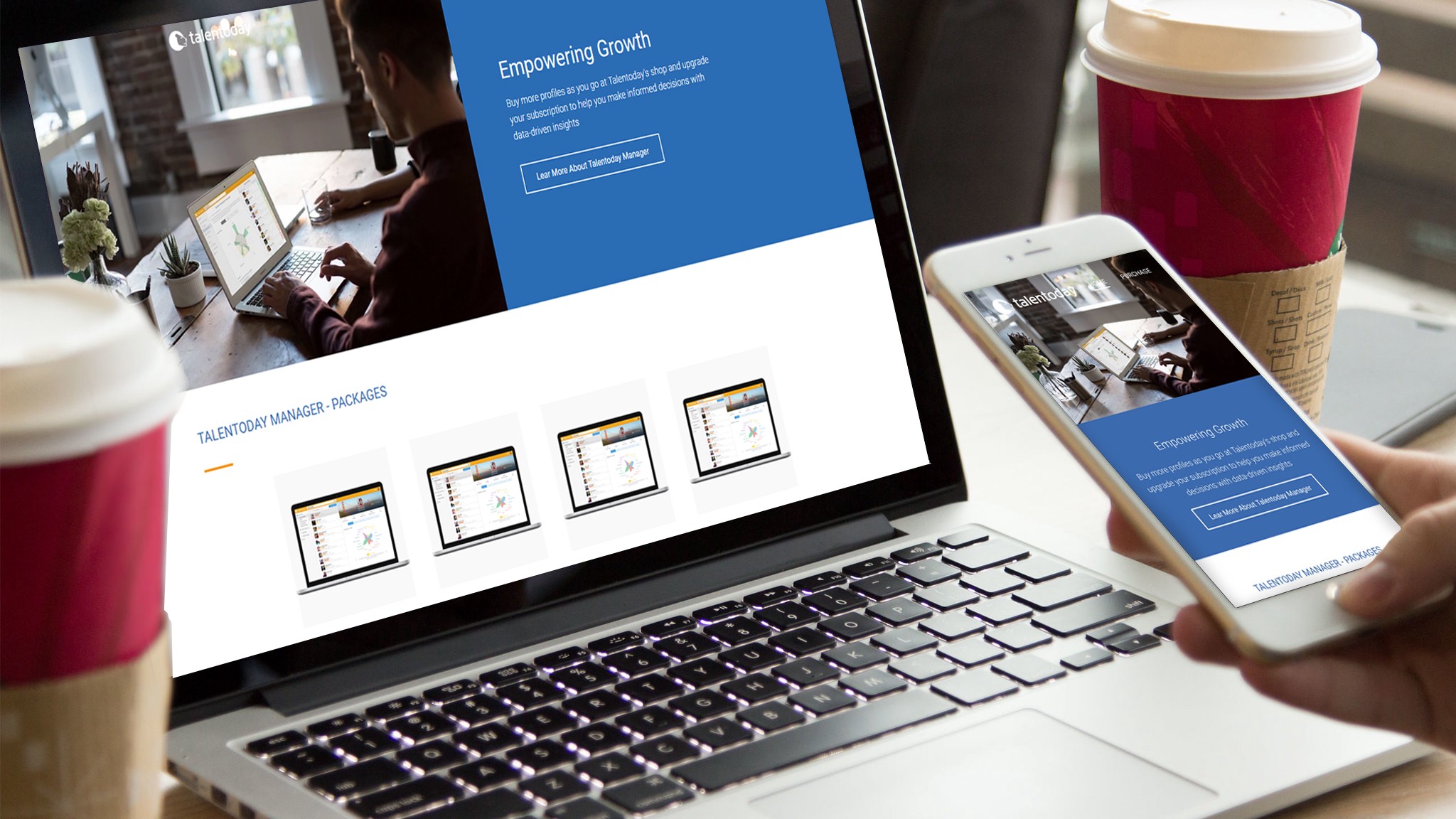
Talentoday, a human centric, people analytics solution that empowers individuals and teams to identify and harness their unique soft skills to grow, recently launched its online shop. I interviewed Benoit Patra, Talentoday’s CTO, and Othmane Lahlou Amine, Key Account Manager, to explain what this initiative means for the company and its customers.
Can you explain what the Talent shop consists of?
Benoît: Our Talentoday Manager solution for HR Professionals is used to better identify talent using an assessment to evaluate an individual’s personality, motivations, and behaviors. Until now, we offered companies unlimited packages that allowed them to recruit one pool of candidates per year to be purchased through their account manager. Then, we realized that one standard offering can be somewhat problematic for some of our clients. Today, we are launching the self-service Talentoday shop, which allows them to buy as many profiles as they need when they need them.
Why did you decide to launch this new and innovative offer?
Othmane: This shop is actually not a surprise for our clients. They requested it, and we made it happen. Our customer satisfaction and feedback drive our innovation, and the shop is actual proof of that. The Talentoday shop now allows them to be autonomous and buy the number of credits they need without any support from the sales or customer success teams. With that said, if anything, this shows that companies are more mature and willing to invest to digitize their HR processes. However, they do not always know where to start, as the scope is quite large. At Talentoday, we offer them a solution that modernizes their recruitment and talent management processes, that is easy to use and access, and that is adaptable to their specific needs.
What is the added value for HR Professionals?
Benoît: The process of purchasing new credits to access additional profiles is completely automated. This allows any HR professional to be fully autonomous, from the order form to invoicing, including refund services and discount offers. Customers buy new packages and pay by credit card or Paypal. We ensure a completely secure payment by partnering with Shopify, a great and proven e-commerce platform.
It is accessible from within the app and for new Talentoday members regardless of the size, location and budget of the company. The only requirement is to have a Talentoday account, which is free and doable in less than 2 minutes.
Othmane: Our client base is extremely diverse, from very small to global; what they shared was the need for autonomy in managing their subscription. The shop allows them to do just that. And by doing so, they save time and money while modernizing their processes throughout their talent life cycle.
In conclusion?
Othmane: The Talentoday shop for HR professionals shows that they can provide their company with a high value-added service, that is easy to use, innovative and accessible by modernizing their image among candidates and employees. Today, HR professionals want and need to be actors in the transformation of their processes. They are convinced that they have a crucial role to play in strengthening their services, and thus enhancing the employer brand; we help them do just that.
Leverage Soft Skills to Accelerate Employee Training

According to the Organization for Economic Co-operation and Development (OECD) figures, just under one-third of French people from 25 to 64 attend work-related training each year. Compared against research showing that 32% of jobs will change with technological progress and 14% risk being automated, this shift may cause concern for employers as they look to remain competitive and sustain business in the future. For employers, training will become crucial to address organizational skill gaps with the introduction of new technologies. From the employee perspective, the 2017 Cegos Barometer shows that, while 99% of French employees believe it is important to train throughout life, only 28% of them consider vocational training to be relevant for companies (Institut YouGov study).
Develop Strategic Social Skills
With the reality of declining employee engagement and increasing turnover, a direct consequences of dissatisfaction with professional training, companies must take the lead in developing the social and situational skills that will ensure their success in a changing environment.
Although the workplace is changing to be increasingly digital, this doesn’t limit employers to “hard skills” but also opens the door for “soft skills” training, which provides long term personal and professional development for employees. In a recent survey conducted by RegionJobs, 82% of the 6,790 respondents (324 recruiters and 6466 candidates) voted that life skills are the most important recruitment criteria. This finding was supported by a study completed by the Employment Guidance Council, confirming the importance of socio-emotional skills — such as self-control, problem solving and perseverance — for the emerging and evolving professions.
Unleashing the Company’s Potential by Unlocking the Potential of Employees
In the same survey from RegionJobs, the findings go on to that “life skills while considered crucial, recruiters still tend to be more flexible with them”. This is similar to the rationalization that occurs when people on a diet “cheat”, a common example of cognitive dissonance.
On the other hand, it is imperative for companies to rethink both recruitment and training. Employees need to be assured that the training provided will enable them to develop professionally by addressing both hard and soft skills. While employer-sponsored training will empower employees to become active participants in their development, while benefiting from the current political and legislative incentives, such as training tax benefits.
Rely on New Training Methods
With improvements to digital learning tools, learner engagement has increased through a personalized approach that takes the individual’s personality and motivations into account. Through having engaged learners, organizations are able to manage training programs upstream and develop skills from within their current organization, allowing them to remain competitive while retaining their existing workforce.
Although the positive impact of these tools is apparent at the macro level, it’s no secret that digital learning solutions can be costly to implement. So, can we evaluate the monetary return on our investment? In looking at IBM’s study on the ROI of training they estimated they were able to save nearly $200 million after implementing an e-learning strategy. Furthermore, through a study conducted by the American Society for Training and Development, it was found that an adapted training program improves employee income by 218%.
Changing working environments and attitudes
As new work environments emerge in the digital age, organizations must encourage new behaviours to facilitate learning — such as, manager engagement for communication of objectives, valuing efforts and rewarding success. It’s also critical to review the company’s decision-making processes and ensure it allows for autonomy, while providing flexibility for new initiatives or innovation.
In looking at soft skills, we’re promoting that it is necessary for employers to promote learning for individuals, which implies a de facto — or inherent — change in management style, allowing for more freedom for both managers and employees.
Sources:
- La formation professionnelle en France, est-elle prête pour l’avenir?, OECD, Fev 2019
- La formation professionnelle en 2017, Observatoire Cegos, Oct 2017
- Turnover Report, SHRM 2019
- Salon du Travail et de la Mobilité Professionnelle, CP, 17 Jan 2019
- Enquête : comment recrute-t-on en 2017?, Priscilla Gout, Sep 2017
- Cognitive dissonance, Talentoday Certification, Talentoday, 2018
- Automatisation, numérisation et emploi, Conseil d’orientation pour l’emploie, tome 2: l’impact sur les compétences, Sep 2017
- LOI n° 2018–771 du 5 septembre 2018 pour la liberté de choisir son avenir professionnel, Legifrance
- The Value of Training, IBM Corporation, 2014
Be Unique: One Size Does Not Fit All

The idea of the “employer brand” is becoming exhausted with a flurry of best practices and standards, but we believe the exhaustion relates to companies being out of touch with what employees are really experiencing. Today there is a need for a holistic and authentic approach across the company’s brand, as the company’s employer brand is central to attracting talent and retaining employees. So, how do we bring new life to the “employer brand” at a time when social interaction is being digitized? What if restoring human relationships was the solution?
By returning to its core values, and purpose, companies can start a new foundation and ensure that it’s attracting talent that match its unique company culture. This fact has been a compressed reality for so long that, in France, the Pacte Law has been enacted to help with the transformative challenges and mutations that companies are facing by emphasizing on the corporate social responsibility (CSR) through the introduction of a new moral pact between a company and its social and environmental ecosystem. QED
Distinctiveness is the lasting differentiation
It is therefore vital for companies to reconnect with their ecosystem by working on identifying what makes them unique and what makes their team(s) exceptional. Through reconnecting with their ecosystem, companies will be able to identify their distinctive image and identity. Which will help them to transparently communicate their authentic purpose and true holistic employee experience — attracting and retaining the right people who share their values and integrate into their sub-culture.
Human Centricity
Given the importance of company culture, and how today it is becoming central in human resource strategy, we’re seeing a number of recruiters utilize soft skills (skills related to interpersonal behaviors) when screening and shortlisting candidates. In fact, by shifting their focus to soft skills, companies get the opportunity to revisit their own values and create that distinctive, strong, social and moral pact that candidates can identify with and employees feel empowered by.
Developing a “People Skills” Directory
Each company is unique, each profession is unique, and the chemistry of the employees is unique.One the many ways to achieve coherence and that goal of distinctiveness is the creation of people skills Directory. An index that list employee behaviors which is intrinsically what makes a company’s culture unique. Conclusions can be used to create that authentic employer brand while evolving overtime based on employee feedback.
To attract the right candidates, foster engagement and retain employees, HR professionals can use elements of their company culture to answer the questions “which projects will naturally speak to employees?” and “on which projects will individuals naturally perform well?” to bridge the gap between employee values and the company’s goals. Ultimately, this will allow companies to create a healthy and remarkable work environment, a strong social pact, a strong culture, and a structural — sustainable — economic growth.
Personality is the catalyst for career performance.

Personality at work has never been more important. More and more recruiters are using personality assessments to evaluate candidates for hiring and job placement.
Although personality represents a small portion of what we’re like at work, it is the catalyst that leads to positive outcomes within an organization in the long run. Afterall, happy employees are motivated employees that drive success to a company.
Understanding a person’s natural specific traits and behaviors at work is essential for two reasons:
- First, it can predict how the individual will interact and behave with others in a group or team.
- Second, personality data identifies whether the individual fits with the tasks and responsibilities required for the position.
Consider traits such as communication and decision-making — for example. Both crucial performance elements for understanding and predicting work performance at an individual and organizational level.
Let’s take a closer look at the two traits mentioned:
Communication
We all know that communication is very important. And spending 8+ hours a day with coworkers certainly requires great communication skills.
A recurring problem we see in recruitment these days is recruiters heavily relying on resumes to screen candidates. Meanwhile, candidates are attempting to convince recruiters of soft skills they do not actually possess. Some will go out of their way to say that that they are “fantastic communicators” simply because they want the job… uh-oh!
So now what? Recruiters are finding that experience and education do not determine the way employees communicate with each other — but in fact, their personalities.Communication is a fundamental element in coworker relationships. The ability to express and communicate can make or break a team.Therefore knowing and understanding the traits and behaviors that form a candidate’s character is essential for predicting how he or she will interact and behave with others in the long term.
Decision making
Personality plays a huge role in the decision making process. Many of us are aware that there are multiple ways to make decisions. From a logical point of view, a decision should be made based on a high potential of achieving success. Yet this is not always the case, as decisions could be colored by a person’s values and motivations. For example, a daring and adventurous employee, may be quick and even impulsive in making decisions. While on the contrary, an analytical employee may need to contemplate every angle before weighing in on a decision.
Hence, organizations are beginning to recognize the importance of personality when looking for candidates to fill job openings. Different roles require different skill sets and aptitudes, and most certainly different personalities. Not everyone is meant to be in leadership position; not everyone has the grit to be a customer contact; and not everyone has the drive to hit sales quotas.
Research studies show that the relationship between personality traits and job performance, using data from tens of thousands of employees significantly predict job performance (Barrick & Mount, 1991). To add, some jobs more than others are sensitive to the affect personality has on performance. Those jobs include positions in sales, customer service and leadership.
Therefore, paying attention to personality traits and motivation drivers is not only prudent but mandatory when hiring or developing talent. Matching the right personality along with the right skills to each job is as important as evaluating a person’s training and hard skills set off of a resume.
By identifying individuals who have a matched personality profile to a job, sourcing becomes simpler.
Try screening employees within your company and select someone that has the soft skills to get the job done right and can be trained to acquire the hard skills. You may be surprised and discover potential high performance sales professionals that are hiding in your organization; and personality assessment tools will help you identify them!
Curious to find out if your candidates have the right personality traits for the job? Start your free trial today and test your candidate quickly & effectively for free!
Top 3 worldwide recruiting trends in 2017

We recently hosted Silicon Valley Recruiters Association (SVRA) at our San Francisco office. The highlight was the panel of 6 experts who spoke about the top problems recruiters face, the importance of data driven soft skills analysis, and the overall trends they foresee for recruiting in 2017 and beyond. Watch the full replay here.
Today we will be featuring the insights of panelist Sankar Venkatraman who has been the Group Product Marketing Manager at LinkedIn for the last five years.
Venkatraman presented data from LinkedIn’s 2017 Annual Global Recruiting Trends Report in which over 4,000 recruiters spanning 35 countries were interviewed about challenges they face, the trends that will define the future of recruiting, how they spend their budgets and where they would like to invest in the future.
Biggest Challenge Recruiters Face: Competition for Talent
According to LinkedIn, by far the greatest challenge recruiters face is competition for talent. Venkatraman simply described this as “how do I stand out in the workplace?” He talked about how he believes LinkedIn initially created this problem because it made it very easy for people to source and find people. The problem is no longer “how do I find a java engineer” but “how do I make it clear that my company is the best place for this java engineer?” He made an interesting connection between this problem and a future trend of recruiting, soft skills, connecting the dots of problem and potential solution, stating that “Talentoday is in the right space for the upcoming 5 years”. Understanding and valuing a candidate’s soft skills and professional motivators will be more important than ever when placing people in the right jobs.
Top Trends that Define the Future of Recruiting
In addition to the biggest challenges recruiters will face, Venkatraman walked us through the top trends projected by LinkedIn. He focused much of his attention on automation. The data shows that recruiters report limited headcount and budget yet hiring demands are growing. Let’s take a closer look at the top three trends you can expect to see in the next 5 years of recruiting.
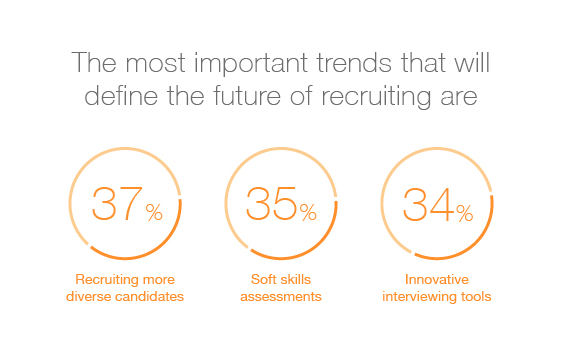
1. Diversity of Candidates
Not only does hiring diverse candidates boost innovation and creativity in the workplace, but by focusing on diversity over time, recruiting success is increased. As we mentioned earlier, competition is the greatest challenge we face as recruiters, and research indicates that diversity attracts talent. According to a Glassdoor survey, two-thirds of people value diversity as important when deciding where to work, the numbers increasing up to 89% of minority job seekers.
It is important to implement this now as it takes time to build a diverse workforce; culture doesn’t pop up overnight. Having a diverse set of employees can also help decrease turnover rates. The same Glassdoor survey said the majority of people wish their employers were doing more to foster diversity — don’t let lack of diversity be the reason your talent is walking out the door early.
*We will be doing a follow up blog with more tips and tricks on how to recruit a diverse population as other panelists went into this in detail, stay tuned!
2. Soft Skills Assessment
When talking trends, soft skills assessment paired with automation were the meat and potatoes of Venkatraman’s presentation. He started by stating the obvious — recruiters are busy. Their teams typically aren’t growing while other teams at their companies’ are. What does this mean for recruiting trends? In this conversation, it boiled down to the screening process. Recruiters need less “noise”. According to Venkatraman, it’s not about how many applicants you have but how many quality applicants you have. Data can help reduce the workload of recruiters and narrow down the quantity of resumes to fewer quality candidates.
There are two main ways that data can help with screening. The more obvious being automated screening which we will get to next in our third vtrend, innovative interviewing tools. The second is that automation can offer a more precise soft skills assessment.
Understanding the hard skills of an individual is pretty straight forward. They have the skill, or they do not. But what is more important these days is an individual’s ability to learn. You can teach someone to code in Javascript but you cannot teach them to have a strong work ethic, how to lead or how to be creative. These are innate traits that are formed over the course of a lifetime, traits that would be nice to know about when hiring for your company. The future, as Venkatraman mentioned will rest on assessments that allow you to measure these traits quickly yet thoroughly.
3. Innovative Interviewing Tools
The other piece to the automation process is innovative interviewing tools. As we mentioned, automation is key. Venkatraman stated how it is imperative for efficiency that recruiters are not screening through millions of candidates for a single job. Automation brings speed and also minimizes human bias which may increase diversity (see how these are all related). Utilizing platforms like HireRight to automate background checks or Hireart to preform video screening of candidates are just a few examples of the tools out there to help simplify interview success.
To summarize, large companies will be focusing on big data to help them attract the most diverse and best talent in the future of recruiting. If you would like to watch the interview with Sankar Venkatraman or the full panel of talent speakers, you can watch here. Stay tuned for more blogs on the other panelists.
— Talentoday
Want valuable insights on your top recruits ? Start your free trial today and use predictive analytics and psychology to make smart hiring decisions. And if you like this post, please hit the ❤️ button below or give me a shout on Twitter.
3 things you must do before hiring candidates
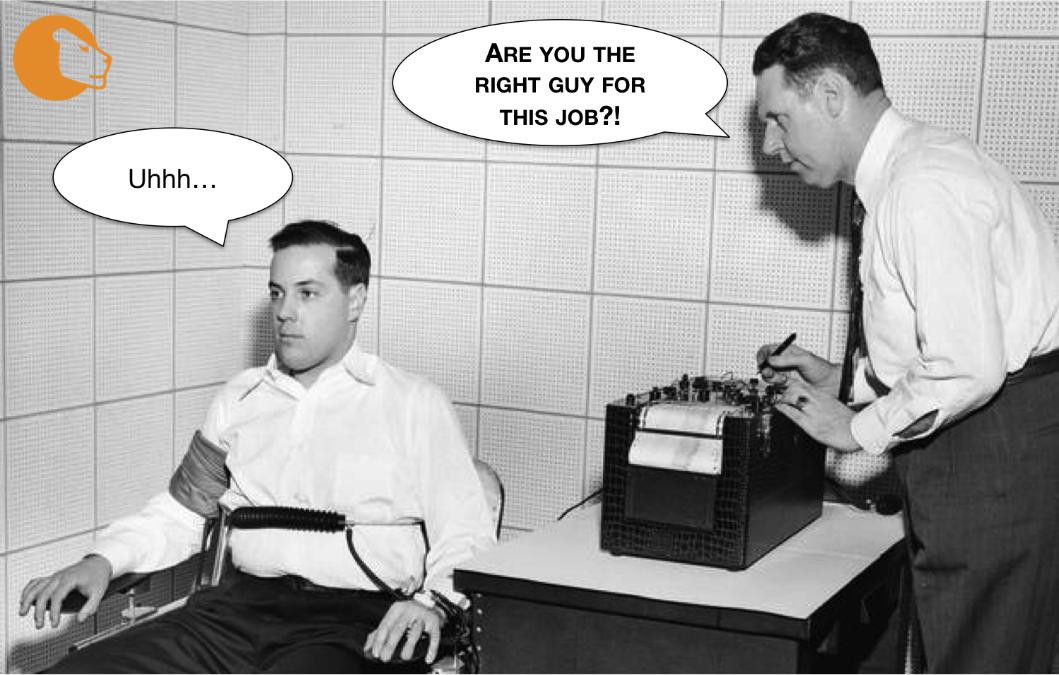
Every manager, HR professional and recruiter faces the same question: Am I recruiting the right candidate for this position? It became essential to be able to discover and acknowledge the value of your future employees and the way they will match to the job position in our fast-paced and technology driven world. Performance is directly correlated to the fit between your candidate’s skills, personality and motivation but also to your company culture, requirements for the job, team members already in place, etc.
Here are the 3 things you need to do:
1 — Evaluate their skills
You want to explore the knowledge and cognizance of every individual, or what the person knows how to do. The skills and aptitudes of a person are usually identified in resumes, diplomas, and experiences. These can also be distinguished via aptitude tests, performance tests, real-life simulations or exercises. Before the meeting, it’s essential to take note of the exact tasks, responsibilities and tools the future employee will have to do, use or learn.
2 — Explore their personalities
This point is crucial and it is the center of the assessment process, in meetings between a recruiter and a candidate. It is not groundbreaking to acknowledge that there is a strong correlation between personality fit and performance in a career. Personality is a complex concept that can be explored in many complementary ways.
We can evaluate it by using personality tests, and with previous employers recommendations, 360-degree feedback or in a well-conducted face-to-face semi-directive interview. The main advantage of using personality tests for interviews (when they are serious!) is that they allow for the standardization and normalization of assessments between different people. Nowadays most are online, easy-to-use and inexpensive. In a way, they allow you to know your candidates before you meet them.
3 — Understand their motivations
Motivation is the third fundamental element to consider while assessing individuals you wish to recruit. It is so important to be aware of people’s aspirations, to know what they seek in their professional lives, and what motivates them. Candidates must select the organization that interests them, identify the people for whom and with which they work, and enjoy the possibilities offered. Every career opportunity must also fit the career plan of the applicant. For example, you can hire the best talent to work for Salesforce.com, but if he is not motivated by the tasks, he will not perform his best, and will leave the company earlier than expected.
If you wish to hire applicants who fit the open position and company culture, make sure you take these points into consideration. While you are free to select a candidate, applicants also choose the company and the people they will work for, their preferred position, and the working framework that matches their expectations.
Adopt the best practices for recruitment and download our free 20 page guide on assessing and selecting talents.


